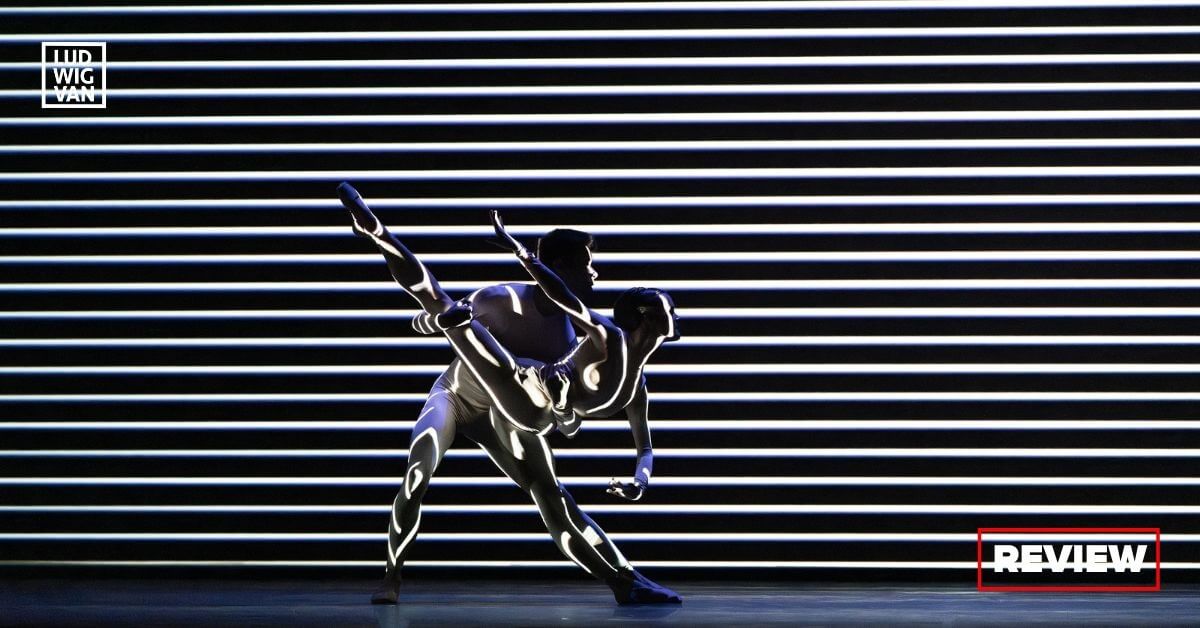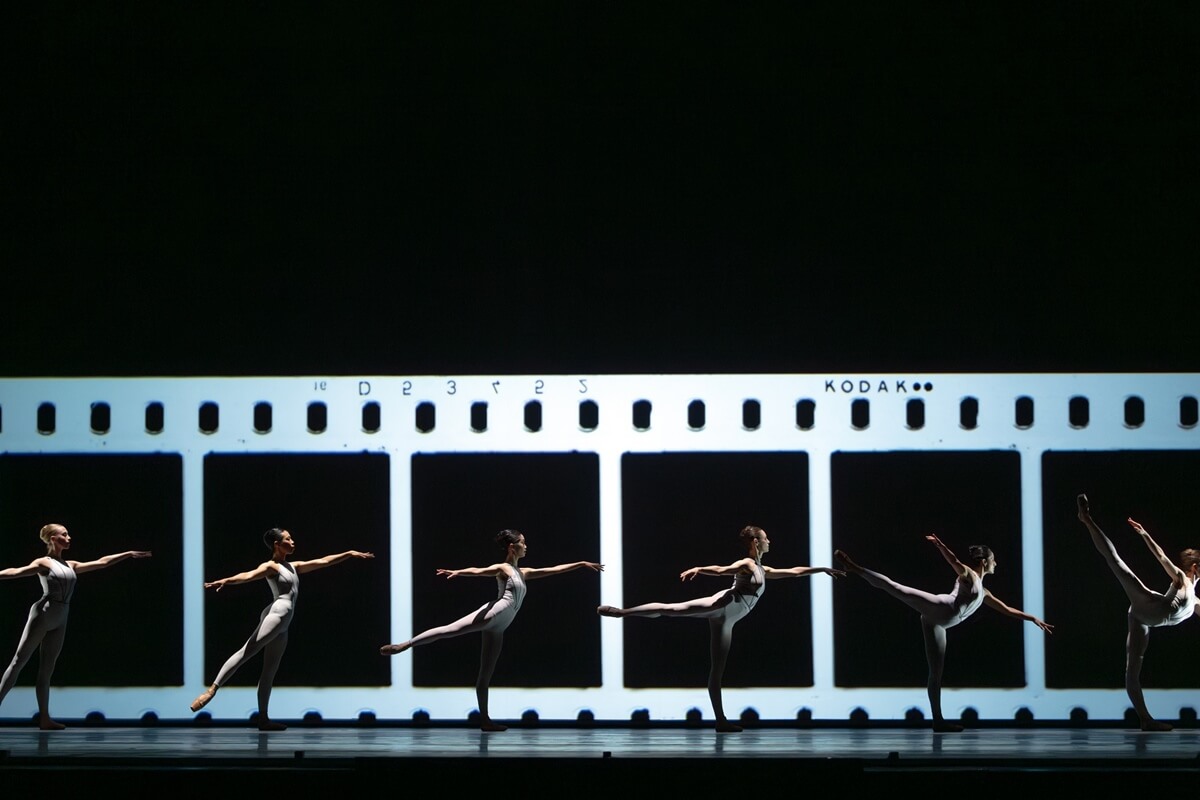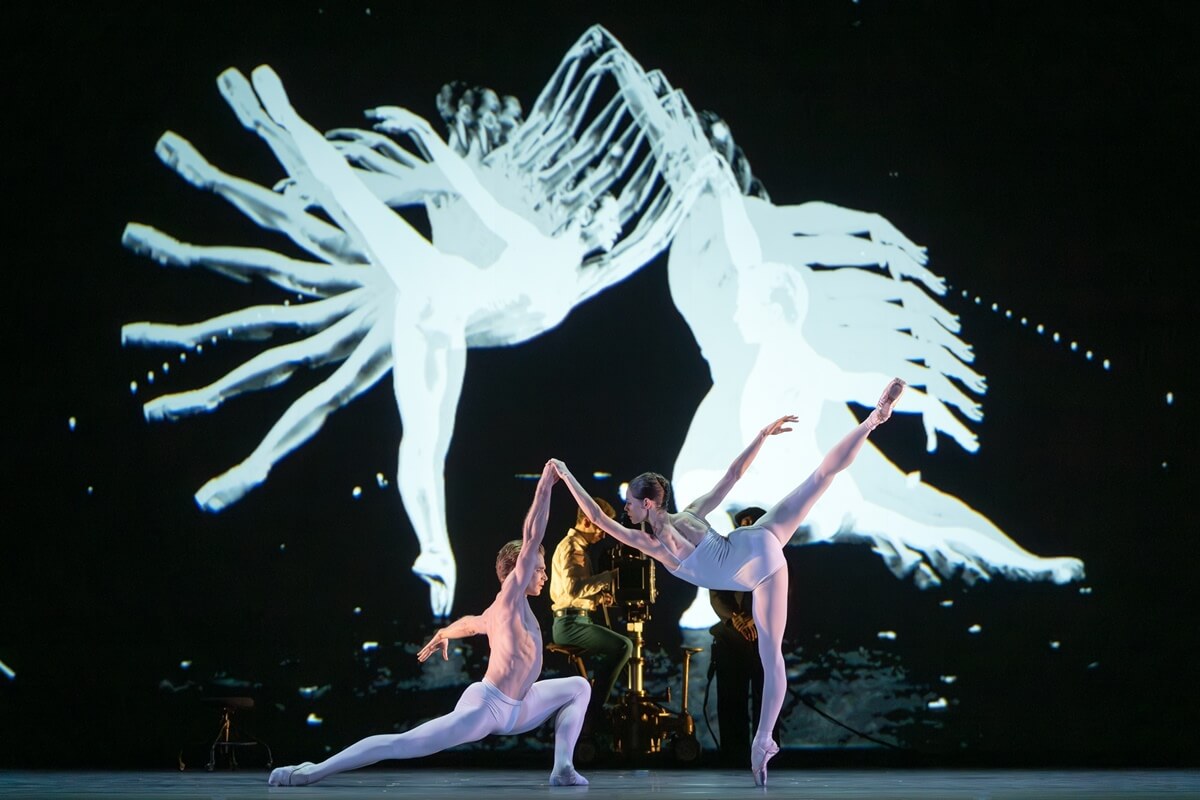
The National Ballet of Canada, Ex Machina & the National Film Board of Canada/Frame by Frame, directed by Robert Lepage, choreographed by Guillaume Côté, Four Seasons Centre, June 2 to 11.(Plus new works from Mad Hot Ballet Gala, June 6.) Tickets here.
When Frame by Frame debuted in 2018, it created a sensation. The awe-inspiring fusion of live action and visual effects, wrapped in a cocoon of technology, was like nothing that the National Ballet had ever attempted before. Now the work has come back for a second viewing, and while the revival is still a stunning piece of creation, it is also different.
With direction by Robert Lepage, and choreography by Guillaume Côté, the ballet is a tribute to the genius of Norman McLaren. Lepage, with his Ex Machina company, is Canada’s leading international man of theatre. Côté is both a principal dancer and choreographic associate with the National. As for McLaren (1914-1987), as the innovative head of the National Film Board of Canada’s animation department, he influenced legions of moviemakers, past, present and future.
This tribute to McLaren (Jack Bertinshaw) is shown through a series of episodes mostly dealing with his visionary experimental films, and featuring his important collaborators like animators Evelyn Lambart (Hannah Galway) and René Jodoin (Noah Parets), and composer Maurice Blackburn (Harrison James). Each is given a pas de deux with McLaren inspired by their particular experimentation. We are also given projected headings telling us relevant names and dates.
Thus, basically, the format is live dance set against a projected backdrop of McLaren’s images, with each vignette being whole unto itself. For example, Wellesley Robertson portrays legendary jazz great Oscar Peterson whose vibrant piano playing was translated by McLaren into shards of pulsing colours that react to sound in Begone Dull Care (1949).

In several cases, the films are actually recreated on stage, they being the award-winning Neighbours (1952), A Chairy Tale (1957), and Pas de Deux (1966). Sections of the music from another film, Ballet Adagio (1972), are remixed and used in the introduction of the Pas De Deux sequence..
For Neighbours, original actors Jean-Paul Ladouceur and Grant Munro are performed by Noah Parets and Albjon Gjorllaku, while Pas de Deux dancers Margaret Mercier and Vincent Warren are brought to life by Genevieve Penn Nabity and James, not to mention the film’s choreographer Ludmilla Chiriaeff (Selene Guerrero-Trujillo). As for the chair, it plays itself.
We also have scenes from McLaren’s personal life, featuring his life partner, actor, director and ballet guru Guy Glover (Alexander Skinner), and National Film Board founder John Grierson (Trygve Cumpston), the man who brought Scots-born McLaren to Canada in 1941.
In fact, one of the most delightful and whimsical scenes in the ballet is the meeting in London between Grierson, McLaren and Glover, manifested by an overhead camera focusing down on a table with the lively conversation being rendered through complicated patterns made by three pairs of hands.
The original ballet was over two hours in length without an intermission. This new version is two hours but with an intermission. Apparently, 12 minutes have been cut. Now five years is a long time, so my memory may be faulty, but what seems to have been edited out, along with some scenes, are those vignettes which show actual technology taking place. In other words, this iteration appears to be a lot more dancey.
For example, I remember the episode with McLaren and Lambart, and their pioneering experimentation in creating images directly on film stock. We actually saw them painting, cutting, pasting and editing. This time, they seem to go directly into a pas de deux that expresses their creative spirit and camaraderie, but without the actual technology, although oscillating images from their film Begone Dull Care do appear projected behind them.
There also seems to be a bigger ensemble, or maybe I’m just more aware this time of the dancers themselves becoming actual images. Seeing the ballet for the first time was such a visual assault on the senses that one couldn’t take it all in.
This time round, I found the use of the ensemble to be brilliant, as dancers merge with projections, which merge with lighting, which merges with sound in breathtaking fashion. For example, in one vignette, somehow the dancers’ bodies actually become adorned with the play of lines against a backdrop of lines, which is impossible to explain in words, but which is visually mindboggling to behold.
Bertinshaw was just a second soloist when he debuted as McLaren. Now a first soloist, he has grown with the role, and radiates confidence and charisma. I just love how Côté choreographically has depicted McLaren in the throes of creation through knee twirls and arm circles, shimmies and shakes, and a body that seems to be consumed in excitement. And then, of course, there is the lightbulb over his head like you see in cartoons.
Côté’s dance language, a mix of mostly contemporary ballet with modern dance, seems perfectly suited for each vignette. I said in my 2018 review that he covered himself in glory in Frame by Frame, and I have an even greater appreciation for his choreographic vision this second time through.
In my original review, I was so taken up with the jaw-dropping impact of Frame by Frame as a whole cloth, that I didn’t give individual mention to Lepage’s creative team, so I would like to correct that omission now. Creatively, this ballet is perfection in the presentation of McLaren’s far-reaching imagination, and clearly, his genius has inspired the genius in others.
Steve Blanchet, creative direction and design. Antoine Bédard, music and sound. Christian Fontaine, set. Michael Gianfrancesco, costumes. Etienne Boucher, lighting. Laurie-Shawn Borzovoy, image projection concept. Thomas Payette/Mirari, video design. Claudia Gendreau, props.
Then there is Lepage, whose direction has overseen the entire project. He is a man of such immense vision, that I absolutely believe this project could not have happened without him. I am convinced there is no subject Lepage won’t tackle despite the difficulties he might encounter. Norman McLaren lives again through Frame by Frame, which, in retrospect, was an unimaginable undertaking.
Whether more dancey or not, this ballet is a technological triumph. Dazzling in its conceit, and brilliant in its execution, Frame by Frame will carry the National’s name into greatness.

The National Ballet of Canada/Mad Hot Ballet, Four Seasons Centre, June 6
Tucked into the run of Frame by Frame was the annual fundraising gala, Mad Hot Ballet, which featured an hour-long dance program, followed by a general reception for the audience at large, and a private dinner for patrons.
The well-planned dance program consisted of the elegiac second movement of David Dawson’s Anima Animus, and the dazzling fourth movement of Balanchine’s Symphony in C. Of particular interest, however, were the middle two works.
First soloist Tanya Howard joined the company in 1998, and after a distinguished career with the National, is retiring this year. For her special send-off, fellow South African and principal dancer Siphesihle November was commissioned to create a solo for her. The result is the very beautiful For All That Is Within.
Garbed by costume designer Greta Constantine in a black body suit covered in glitter, and sporting two very large white mutton oversleeves, Howard comes to the front of the stage and begins to put on her point shoes to the sound of Afrikaans word poetry.
To the then angelic boys’ voices of Pie Jesu, she lyrically moves about the stage while exhibiting many emotional shifts, abruptly stopping, as sort of a reality check, then moving slowing back into darkness.
Thus, in one short but little gem of a piece, we see Howard’s beginning as a dancer (the point shoes), her career in dance (the lovely grace and lyricism of the movement), and the sadness of leaving the stage (her fade to black, as it were).
The audience rewarded Howard with a standing ovation which moved the dancer to tears. It was an emotional moment for everyone.
I have mentioned in the past that November has a lot of potential as a choreographer, and this work proves that statement. I have only seen two pieces by him, but each has had volumes of meaning underscoring very eye-catching movement.
The second short piece, fractured, was created by Ethan Colangelo for the Eric Bruhn Competition this past March, and I have to say, it did not really register on me at the time, although I did appreciate how it showed off the physicality of dancers Emerson Dayton and Noah Parets in a contemporary work. But as sometimes happens, when you take a piece into a new setting, suddenly it shines.
Away from the competition, fractured proves to be a substantive piece. Colangelo has crafted fractured body movement, that depicts a fractured relationship. Angst-filled music by Nicolas Jaar and Ben Waters provide the soundscape for bodies and limbs that shift into bizarre angles, almost tortured out of shape.
At several points, the man slams his arm down in repeated angry blows as if he can’t contain his despair, while the choreography for the woman is more faltering and repressed. The partnering is punishing and intense when the two manage to come together, although they seem to each be in their own world.
Colangelo is joining the National as choreographic associate this July, and it will be interesting to watch the works that he creates for the company.
#LUDWIGVAN
Get the daily arts news straight to your inbox.



